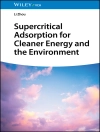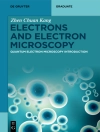This ninth volume in the series concentrates on in situ spectroscopic methods and combines a balanced mixture of theory and applications, making it highly readable for chemists and physicists, as well as for materials scientists and engineers. As with the previous volumes, all the chapters continue the high standards of this series, containing numerous references to further reading and the original literature, for easy access to this new field. The editors have succeeded in selecting highly topical areas of research and in presenting authors who are leaders in their fields, covering such diverse topics as diffraction studies of the electrode-solution interface, thin organic films at electrode surfaces, linear and non-linear spectroscopy as well as sum frequency generation studies of the electrified solid-solution interface, plus quantitative SNIFTIRS and PM-IRRAS. Special attention is paid to recent advances and developments, which are critically and thoroughly discussed.
The result is a compelling set of reviews, serving equally well as an excellent and up-to-date source of information for experienced researchers in the field, as well as as an introduction for newcomers.
表中的内容
Series Preface V
Volume Preface XV
List of Contributors XVII
1 In-situ X-ray Diffraction Studies of the Electrode/Solution Interface 1
Christopher A. Lucas and Nenad M. Markovic
1.1 Introduction 1
1.2 Experimental 2
1.3 Adsorbate-induced Restructuring of Metal Substrates 4
1.3.1 Surface Relaxation 5
1.3.1.1 Pt Monometallic and Bimetallic Surfaces 5
1.3.1.2 Group IB Metals 12
1.3.2 Surface Reconstruction 16
1.4 Adlayer Structures 22
1.4.1 Anion Structures 23
1.4.2 CO Ordering on the Pt(111) Surface 28
1.4.3 Underpotential Deposition (UPD) 31
1.5 Reactive Metals and Oxides 36
1.6 Conclusions and Future Directions 41
Acknowledgments 42
References 42
2 UV-visible Reflectance Spectroscopy of Thin Organic Films at Electrode Surfaces 47
Takamasa Sagara
2.1 Introduction 47
2.2 The Basis of UV-visible Reflection Measurement at an Electrode Surface 49
2.3 Absolute Reflection Spectrum versus Modulated Reflection Spectrum 50
2.4 Wavelength-modulated UV-visible Reflectance Spectroscopy 53
2.5 Potential-modulated UV-visible Reflectance Spectroscopy 54
2.6 Instrumentation of the Potential-modulated UV-visible Reflection Measurement 55
2.7 ER Measurements for Redox-active Thin Organic Films 57
2.8 Interpretation of the Reflection Spectrum 62
2.9 Reflection Measurement at Special Electrode Configurations 65
2.10 Estimation of the Molecular Orientation on the Electrode Surface 68
2.10.1 Estimation of the Molecular Orientation on the Electrode Surface using the Redox ER Signal 69
2.10.2 Estimation of the Molecular Orientation on the Electrode Surface using the Stark Effect ER Signal 72
2.11 Measurement of Electron Transfer Rate using ER Measurement 73
2.11.1 Redox ER Signal in Frequency Domain 73
2.11.2 Examples of Electron Transfer Rate Measurement using ER Signal 76
2.11.3 Improvement in Data Analysis 78
2.11.4 Combined Analysis of Impedance and Modulation Spectroscopic Signals 79
2.11.5 Upper Limit of Measurable Rate Constant 82
2.11.6 Rate Constant Measurement using an ER Voltammogram 82
2.12 ER Signal Originated from Non-Faradaic Processes – a Quick Overview 83
2.13 ER Signal with Harmonics Higher than the Fundamental Modulation Frequency 84
2.14 Distinguishing between Two Simultaneously Occurring Electrode Processes 85
2.15 Some Recent Examples of the Application of ER Measurement for a Functional Electrode 87
2.16 Scope for Future Development of UV-visible Reflection Measurements 91
2.16.1 New Techniques in UV-visible Reflection Measurements 91
2.16.2 Remarks on the Scope for Future Development of UV-visible Reflection Measurements 92
Acknowledgments 93
References 93
3 Epi-fluorescence Microscopy Studies of Potential Controlled Changes in Adsorbed Thin Organic Films at Electrode Surfaces 97
Dan Bizzotto and Jeff L. Shepherd
3.1 Introduction 97
3.2 Fluorescence Microscopy and Fluorescence Probes 99
3.3 Fluorescence near Metal Surfaces 100
3.4 Description of a Fluorescence Microscope for Electrochemical Studies 101
3.4.1 Microscope Resolution 103
3.4.2 Image Analysis 104
3.5 Electrochemical Systems Studied with Fluorescence Microscopy 106
3.5.1 Adsorption of C18OH on Au(111) 108
3.5.2 The Adsorption and Dimerization of 2-(2_-Thienyl)pyridine (TP) on Au(111) 114
3.5.3 Fluorescence Microscopy of the Adsorption of DOPC onto an Hg Drop 115
3.5.4 Fluorescence Microscopy of Liposome Fusion onto a DOPC-coated Hg Interface 118
3.5.5 Fluorescence Imaging of the Reductive Desorption of an Alkylthiol SAM on Au 120
3.6 Conclusions and Future Considerations 122
Structures and Abbreviations 123
Acknowledgments 124
References 124
4 Linear and Non-linear Spectroscopy at the Electrified Liquid/Liquid Interface 127
David J. Fermín
4.1 Introductory Remarks and Scope of the Chapter 127
4.2 Linear Spectroscopy 128
4.2.1 Total Internal Reflection Absorption/Fluorescence Spectroscopy 128
4.2.2 Potential-modulated Reflectance/Fluorescence in TIR 134
4.2.3 Quasi-elastic Laser Scattering (QELS) 139
4.2.4 Other Linear Spectroscopic Studies at the Neat Liquid/Liquid Interface 142
4.3 Non-linear Spectroscopy 146
4.3.1 Second Harmonic Generation 146
4.3.2 Vibrational Sum Frequency Generation 151
4.4 Summary and Outlook 154
Acknowledgments 157
Symbols 157
Abbreviations 158
References 159
5 Sum Frequency Generation Studies of the Electrified Solid/Liquid Interface 163
Steven Baldelli and Andrew A. Gewirth
5.1 Introduction 163
5.1.1 Theoretical Background 163
5.1.2 SFG Intensities 164
5.1.3 Resonant Term 165
5.1.4 Non-resonant Term 166
5.1.5 Phase Interference 167
5.1.6 Orientation Information in SFG 168
5.1.7 Phase Matching 169
5.1.8 Surface Optics 169
5.1.9 Data Analysis Reference 171
5.1.10 Experimental Designs 172
5.1.11 Spectroscopy Cell 173
5.2 Applications of SFG to Electrochemistry 174
5.2.1 CO Adsorption 176
5.2.1.1 Polarization Studies 178
5.2.1.2 Potential Dependence 178
5.2.1.3 CO on Alloys 179
5.2.1.4 Solvent Effects 180
5.2.2 Adsorption of upd and opd H 180
5.2.3 CN on Pt and Au Electrodes 180
5.2.3.1 CN/Pt 180
5.2.3.2 CN/Au 183
5.2.4 OCN and SCN 183
5.2.5 Pyridine and Related Derivatives 183
5.2.6 Dynamics of CO and CN Vibrational Relaxation 185
5.2.7 Solvent Structure 187
5.2.7.1 Nonaqueous Solvents 187
5.2.7.2 Aqueous Solvents 191
5.2.8 Monolayers and Corrosion 193
5.3 Conclusion 193
Acknowledgments 194
References 195
6 IR Spectroscopy of the Semiconductor/Solution Interface 199
Jean-Noël Chazalviel and François Ozanam
6.1 Introduction 199
6.2 IR Spectroscopy at an Interface 200
6.2.1 Basic Principles of IR Spectroscopy 200
6.2.2 External versus Internal Reflection 201
6.3 Practical Aspects at an Electrochemical Interface 203
6.3.1 How Potential can Affect IR Absorption 204
6.3.2 How to Isolate Potential-sensitive IR Absorption 205
6.4 What can be Learnt from IR Spectroscopy at the Interface 207
6.4.1 Vibrational Absorption of Interfacial and Double-Layer Species 208
6.4.2 Vibrational Absorption of Species outside the Double-Layer 211
6.4.3 Electronic Absorption 213
6.5 Effect of Light Polarization in ATR Geometry 217
6.5.1 Selection Rules for a Polarized IR Beam 218
6.5.2 Case of Strongly Polar Species: LO-TO Splitting 218
6.5.3 Polarization Modulation 222
6.6 Dynamic Information from a Modulation Technique 222
6.7 Case of Rough or Complex Interfaces 224
6.7.1 Surface Roughness 225
6.7.2 Composite Interface Films 226
6.8 Conclusion 229
References 230
7 Recent Advances in in-situ Infrared Spectroscopy and Applications in Single-crystal Electrochemistry and Electrocatalysis 233
Carol Korzeniewski
7.1 Introduction 233
7.2 Experimental 234
7.2.1 Spectrometer Systems 234
7.2.2 Spectrometer Throughput Considerations 234
7.2.3 Detectors 235
7.2.4 Signal-to-Noise Ratio Considerations 236
7.2.5 Signal Digitization 236
7.2.6 Signal Modulation and Related Data Acquisition Methods 237
7.3 Applications 238
7.3.1 Adsorption and Reactivity at Well-defined Electrode Surfaces 238
7.3.1.1 Adsorption on Pure Metals 238
7.3.1.2 Electrochemistry at Well-defined Bimetallic Electrodes 241
7.3.2 SEIRAS 244
7.3.3 Infrared Spectroscopy as a Probe of Surface Electrochemistryat Metal Catalyst Particles 249
7.3.4 Nanostructured Electrodes and Optical Considerations 253
7.3.5 Emerging Instrumental Methods and Quantitative Approaches 254
7.3.5.1 Step-scan Interferometry 254
7.3.5.2 Two-dimensional Infrared Correlation Analysis 256
7.3.5.3 Quantitation of Molecular Orientation 259
7.4 Summary 262
Acknowledgments 263
References 263
8 In-situ Surface-enhanced Infrared Spectroscopy of the Electrode/Solution Interface 269
Masatoshi Osawa
8.1 Introduction 269
8.2 Electromagnetic Mechanism of SEIRA 271
8.3 Experimental Procedures 273
8.3.1 Electrochemical Cell and Optics 273
8.3.2 Preparation of Thin-film Electrodes 276
8.4 General Features of SEIRAS 279
8.4.1 Comparison of SEIRAS with IRAS 279
8.4.2 Surface Selection Rule and Molecular Orientation 281
8.4.3 Comparison of SEIRA and SERS 284
8.4.4 Baseline Shift by Adsorption of Molecules and Ions 285
8.5 Selected Examples 287
8.5.1 Reactions of a Triruthenium Complex Self-assembled on Au 288
8.5.2 Cytochrome c Electrochemistry on Self-assembled Monolayers 290
8.5.3 Molecular Recognition at the Electrochemical Interface 293
8.5.4 Hydrogen Adsorption and Evolution on Pt 296
8.5.5 Oxidation of C1 Molecules on Pt 298
8.6 Advanced Techniques for Studying Electrode Dynamics 302
8.6.1 Rapid-scan Millisecond Time-resolved FT-IR Measurements 302
8.6.2 Step-scan Microsecond Time-resolved FT-IR Measurements 303
8.6.3 Potential-modulated FT-IR Spectroscopy 308
8.7 Summary and Future Prospects 309
Acknowledgments 310
References 310
9 Quantitative SNIFTIRS and PM IRRAS of Organic Molecules at Electrode Surfaces 315
Vlad Zamlynny and Jacek Lipkowski
9.1 Introduction 315
9.2 Reflection of Light from Stratified Media 316
9.2.1 Reflection and Refraction of Electromagnetic Radiation at a Two-phase Boundary 317
9.2.2 Reflection and Refraction of Electromagnetic Radiation at a Multiple-phase Boundary 323
9.3 Optimization of Experimental Conditions 325
9.3.1 Optimization of the Angle of Incidence and the Thin-cavity Thickness 327
9.3.2 The Effect of Incident Beam Collimation 330
9.3.3 The Choice of the Optical Window Geometry and Material 331
9.4 Determination of the Angle of Incidence and the Thin-cavity Thickness 336
9.5 Determination of the Isotropic Optical Constants in Aqueous Solutions 338
9.6 Determination of the Orientation of Organic Molecules at the Electrode Surface 343
9.7 Development of Quantitative SNIFTIRS 344
9.7.1 Description of the Experimental Set-up 344
9.7.2 Fundamentals of SNIFTIRS 347
9.7.3 Calculation of the Tilt Angle from SNIFTIRS Spectra 348
9.7.4 Applications of Quantitative SNIFTIRS 349
9.8 Development of Quantitative in-situ PM IRRAS 356
9.8.1 Introduction 356
9.8.2 Fundamentals of PM IRRAS and Experimental Set-up 357
9.8.3 Principles of Operation of a Photoelastic Modulator 360
9.8.4 Correction of PM IRRAS Spectra for the PEM Response Functions 364
9.8.5 Background Subtraction 366
9.8.6 Applications of Quantitative PM IRRAS 368
9.9 Summary and Future Directions 373
Acknowledgments 373
References 374
10 Tip-enhanced Raman Spectroscopy – Recent Developments and Future Prospects 377
Bruno Pettinger
10.1 General Introduction 377
10.2 SERS at Well-defined Surfaces 379
10.3 Single-molecule Raman Spectroscopy 384
10.4 Tip-enhanced Raman Spectroscopy (TERS) 391
10.4.1 Near-field Raman Spectroscopy with or without Apertures 391
10.4.2 First TERS Experiments 395
10.4.3 TERS on Single-crystalline Surfaces 401
10.5 Outlook 409
10.5.1 Recent Results 409
10.5.2 New Approaches on the Horizon 409
Acknowledgment 410
References 411
Subject Index 419
关于作者
Richard C. Alkire is Professor Emeritus of Chemical & Biomolecular Engineering Charles and Dorothy Prizer Chair at the University of Illinois, Urbana, USA. He obtained his degrees at Lafayette College and University of California at Berkeley. He has received numerous prizes, including Vittorio de Nora Award and Lifetime National Associate award from National Academy.
Dieter M. Kolb is Professor of Electrochemistry at the University of Ulm, Germany. He received his undergraduate and Ph D degrees at the Technical University of Munich. He was a Postdoctoral Fellow at Bell Laboratories, Murray Hill, NJ, USA. He worked as a Senior Scientist at the Fritz-Haber-Institute of the Max-Planck-Society, Berlin and completed his habilitation at the Free University of Berlin, where he also was Professor. Prof. Kolb has received many prizes and is a member of several societies.
Jacek Lipkowski is Professor at the Department of Chemistry and Biochemistry at the University of Guelph, Canada. His research interests focus on surface analysis and interfacial electrochemistry. He has authored over 120 publications and is a member of several societies, including a Fellow of the International Society of Electrochemistry.
Philip N. Ross has recently retired from his position as a Senior Scientist at the Lawrence Berkeley National Laboratory. He received his academic degrees at Yale University, New Haven, CT, and University of Delaware, Newark, DL. He has received the David C. Grahame Award of the Electrochemical Society, and is a member of several Committees and Advisory Boards.












